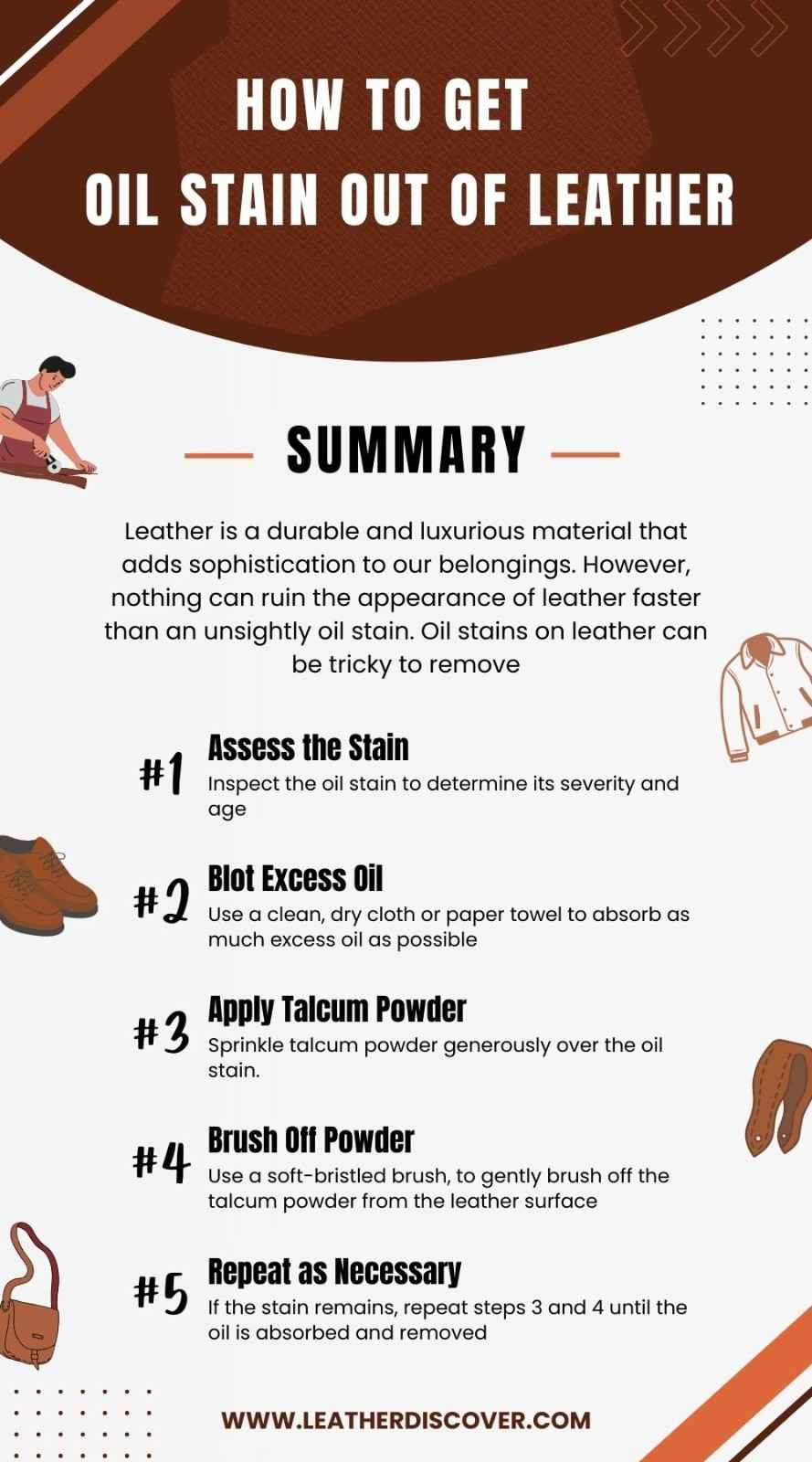Leather is a durable and luxurious material that adds sophistication to our belongings. However, nothing can ruin the appearance of leather faster than an unsightly oil stain.
Whether from cooking, makeup, or a spill, oil stains on leather can be tricky to remove.
But fear not! This comprehensive guide will explore effective and safe methods to remove oil stains from leather, restoring its pristine appearance.

How to Get Oil Stain Out of Leather?
Here’s a table on how to get an oil stain out of leather:
What Are the Products You Can Use to Clean Oil Stain Out of Leather?
When it comes to getting oil out of leather, there are several options you can choose from:
- Cornstarch or Baking Soda: If the oil stain is fresh, sprinkle cornstarch or baking soda on the stain to absorb the oil. Let it sit on the stain for a few hours or overnight, then brush it off with a soft brush.
- Talcum Powder: Talcum powder can also absorb oil stains from leather. Sprinkle the powder on the stain, let it sit for a few hours, then brush it off gently.
- Leather Degreaser: There are specific leather degreasers designed to remove oil and grease stains from leather. Follow the manufacturer’s instructions for the best results.
- Dishwashing Liquid: Mild dishwashing liquid can remove oil stains from leather. Mix a small amount with warm water to create a gentle cleaning solution. Dampen a clean cloth with the solution and gently blot the stained area. Make sure not to saturate the leather.
- White Vinegar: White vinegar can help remove oil stains from leather. Mix one part vinegar with one part water, dampen a clean cloth with the solution, and gently wipe the stained area.
- Rubbing Alcohol: Rubbing alcohol can effectively remove oil stains from leather. Dampen a clean cloth with rubbing alcohol and gently blot the stained area.
- Leather Cleaner: Use a leather cleaner specifically designed for the leather you are treating. Follow the manufacturer’s instructions for the best results.
Source: Trenton & Health YT Channel
How Long Does It Take To Get Oil Stain Out of Leather?
The time it takes to remove an oil stain from leather can vary depending on several factors, including the severity of the stain, the cleaning method used, and the type of leather.
Here’s a general guideline:
- If you notice an oil stain, act quickly to blot the excess oil with a clean cloth or paper towel. This can help prevent the oil from setting into the leather, making the stain easier to remove.
- Methods that involve using absorbent materials like baking soda, cornstarch, or talcum powder may require several hours, or even overnight, to effectively absorb the oil from the leather.
- Methods involving cleaning solutions, such as dish soap or vinegar, may require some time for the solution to break down the oil stain and lift it from the leather.
- If you’re using a commercial leather cleaner or stain remover, follow the manufacturer’s instructions regarding application and drying time. This can vary depending on the product.
- The time it takes for professional cleaning can vary based on the expertise of the cleaner and the complexity of the stain.
What Happens When Oil Stains Remain on Leather?
How to Prevent Oil Stain on Leather in the Future?
Preventing oil stains on leather involves proactive measures to protect your leather items and minimize the risk of staining. Here are some tips to help prevent oil stains on leather in the future:
1. Use Protective Products
Apply a leather protector or waterproofing spray to create a barrier that repels oil and water from penetrating the leather.
Be sure to follow the manufacturer’s instructions for application.
2. Handle With Clean Hands
Avoid handling leather items with dirty or greasy hands, this can transfer oils and dirt onto the leather surface.
3. Store Properly
Store leather items in a clean, dry area away from oil, grease, and direct sunlight. Proper storage can help prevent accidental staining and minimize exposure to environmental contaminants.
4. Regular Cleaning and Maintenance
Clean and condition your leather items regularly using products specifically designed for leather care.
This helps to remove dirt, oils, and other residues that can contribute to staining over time.
5. Address Stains Promptly
If you notice an oil stain on your leather item, address it promptly using appropriate cleaning methods to prevent it from setting and becoming more difficult to remove.
6. Avoid Harsh Chemicals
Avoid harsh chemicals or cleaning products that can damage or discolor leather. Stick to gentle, leather-safe cleaning solutions and methods.
Source: How2RemoveStains YT Channel
Conclusion
Dealing with oil stains on leather doesn’t have to be daunting.
With the right materials and techniques, you can effectively remove oil stains and restore the beauty of your leather items.
Remember to approach the stain removal process gently and patiently, as aggressive methods can damage the leather.
By following the steps in this guide and proactively taking preventive measures, you can ensure that your leather belongings maintain their elegant appearance for many years.
Resources Consulted
- What Is Caiman Leather? A Detailed Guide - July 25, 2024
- What Is Tumbled Leather?A Complete Guide - July 25, 2024
- What Is Kip Leather? Premium Leather Choice - July 24, 2024
